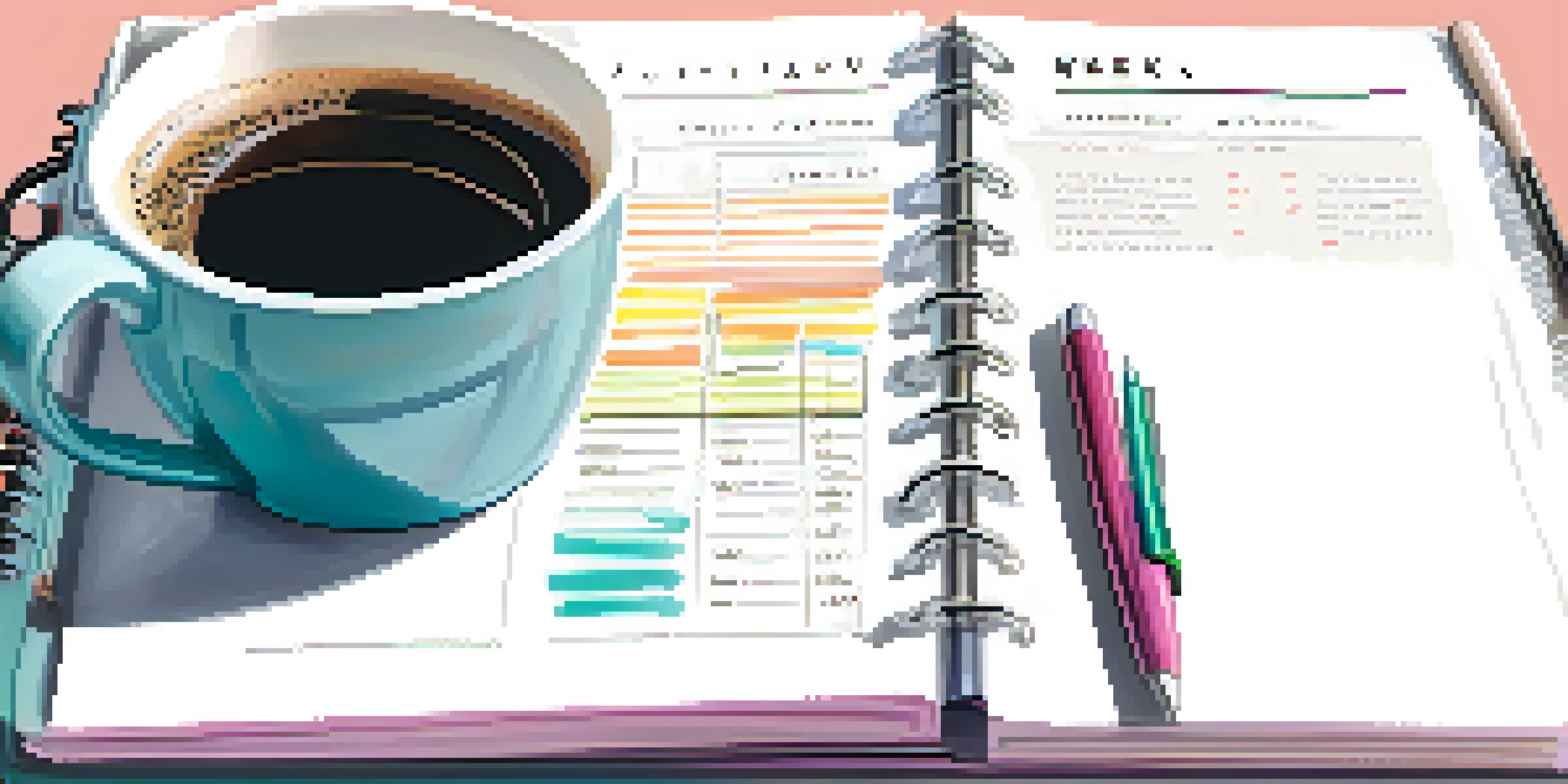Choosing Between Agile and Waterfall: A Decision-Making Guide

Understanding Agile and Waterfall Methodologies
Agile and Waterfall are two prominent project management methodologies, each with unique characteristics. Waterfall is a linear approach, where each project phase must be completed before moving to the next, much like climbing stairs one step at a time. In contrast, Agile is iterative, allowing for flexibility and adaptability as projects evolve, resembling a flowing river that adjusts to its surroundings.
The greatest danger in times of turbulence is not the turbulence; it is to act with yesterday's logic.
Choosing the right methodology can significantly impact your project's success. Waterfall might be preferable for projects with clearly defined requirements and a predictable timeline, while Agile shines in environments where change is frequent and feedback is essential. Understanding these foundational differences is crucial in making an informed decision.
Ultimately, both methodologies aim to deliver quality results, but their approaches differ greatly. By grasping the essence of Agile and Waterfall, you can better assess which method aligns with your project goals and team dynamics.
Assessing Project Requirements and Goals
Before deciding on a methodology, it's important to evaluate your project requirements and goals. Consider whether your project has fixed requirements or if it’s likely to evolve over time. For instance, developing a new software application with rapidly changing user needs would benefit from Agile's flexibility.

Conversely, if you’re managing a construction project with strict regulations and a clear blueprint, Waterfall might be the more suitable choice. This methodology allows for meticulous planning and execution, ensuring each phase is completed before progressing. Identifying the nature of your project is key to this decision-making process.
Choose Methodology Based on Needs
Selecting between Agile and Waterfall depends on your project's requirements, team dynamics, and risk levels.
In summary, understanding your project’s requirements and desired outcomes will guide you in selecting the most effective methodology. A thorough assessment at this stage can save time, resources, and potential headaches down the line.
Team Structure and Collaboration Styles
The structure of your team and their collaboration styles play a vital role in choosing between Agile and Waterfall. Agile thrives in environments where team members work closely together, often in cross-functional teams that encourage collaboration and communication. This approach fosters a sense of ownership and accountability among team members.
In the middle of difficulty lies opportunity.
On the other hand, Waterfall may suit teams that prefer clear roles and responsibilities with a more hierarchical structure. In this scenario, each team member has a defined task and timeline, making it easier to track progress. Mapping your team dynamics to the appropriate methodology can enhance productivity and morale.
Ultimately, recognizing the strengths of your team and how they collaborate can lead to a smoother project experience. Aligning your team’s structure with the chosen methodology will empower them to perform at their best.
Evaluating Risk and Uncertainty Levels
When choosing a project methodology, it's essential to assess the level of risk and uncertainty involved. Agile is particularly beneficial for projects with high levels of uncertainty, as it allows for regular reassessments and adjustments based on user feedback and changing conditions. This adaptability is crucial in fast-paced environments.
In contrast, Waterfall provides a more stable framework for projects with lower risk, where requirements are unlikely to change. By following a predefined plan, teams can minimize surprises and ensure that each phase is thoroughly completed before moving forward. This method is ideal for projects where the outcome is predictable and well-understood.
Stakeholder Engagement Matters
Regular feedback and involvement from stakeholders are crucial in Agile, while Waterfall may suit projects with defined requirements.
By evaluating the risk factors associated with your project, you can better align your methodology choice with the potential challenges you might face. Understanding these aspects will not only guide your decision but also enhance your project’s chances for success.
Timeline and Budget Considerations
Another critical factor in choosing between Agile and Waterfall is your project timeline and budget. Waterfall often requires a more extensive upfront investment in planning, which can lead to a well-defined budget and timeline. This predictability can be beneficial for stakeholders who need to plan resources and expectations carefully.
On the other hand, Agile can lead to a more dynamic budget and timeline, as projects are broken down into smaller phases or sprints. This allows for ongoing assessment and prioritization of features, meaning adjustments can be made based on feedback or changing conditions. However, this flexibility can sometimes lead to budget overruns if not managed carefully.
In conclusion, understanding your financial constraints and time limitations is pivotal in making the right methodological choice. A clear picture of your project's monetary and temporal needs will help you navigate the complexities of project management.
Stakeholder Engagement and Feedback Loops
Stakeholder engagement is another significant aspect to consider when choosing a methodology. Agile methodologies prioritize regular feedback and iterative progress, making them ideal for projects where stakeholder input is crucial. Frequent check-ins and reviews keep stakeholders informed and involved, ensuring their needs are met throughout the project.
Waterfall, conversely, often involves less frequent stakeholder engagement, with reviews typically occurring at the end of each phase. This approach can be beneficial for projects with well-defined requirements and minimal changes expected. However, it can also lead to disconnects if stakeholders feel out of the loop during the project’s progression.
Learn from Past Experiences
Reflecting on previous projects can guide you in choosing the most effective methodology for your current undertaking.
Assessing how involved your stakeholders want to be can guide you in selecting the appropriate methodology. By aligning engagement strategies with your chosen approach, you can foster stronger relationships and achieve better project outcomes.
Learning from Past Projects and Experiences
Reflecting on past projects can provide valuable insights into what methodology may work best for your current undertaking. If your team has previously succeeded with Agile, it might make sense to continue utilizing that approach. Drawing from past experiences helps identify patterns in project successes and challenges.
Conversely, if Waterfall has proven effective in your organization's previous projects, leveraging that familiarity can lead to smoother execution. Each methodology has its place, and understanding the history of your team's work can clarify which path to take moving forward.

Ultimately, learning from the successes and mistakes of the past can inform your current decision-making process. By analyzing previous projects, you can enhance your methodology choice and set the stage for future success.
Making the Final Decision: Key Takeaways
In conclusion, deciding between Agile and Waterfall requires careful consideration of various factors, including project requirements, team dynamics, risk levels, and stakeholder engagement. Each methodology has its strengths and weaknesses, making it essential to align your choice with your specific project context. Remember, there’s no one-size-fits-all answer; what works for one project might not suit another.
As you weigh your options, consider leveraging insights from past experiences and the preferences of your team and stakeholders. This collaborative approach will not only enhance your decision-making but also foster a sense of ownership among team members. Engaging your team in this process can yield a better understanding of which methodology aligns with your goals.
Ultimately, the right choice will set the foundation for your project's success. By taking the time to evaluate your options thoughtfully, you’ll be better equipped to navigate the complexities of project management and achieve your desired outcomes.